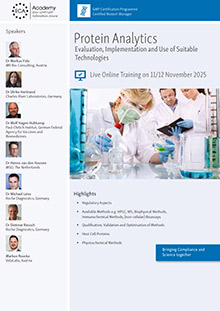EMA issues Draft Guideline on Process Validation for Biotechnological Products - an Analysis

Recommendation
5/6 February 2026
In a news in the GMP Newsletter last week we already briefly reported about the EM Draft Guideline of Process Validation for biotechnological products and also announced the following more detailed analysis.
As already mentioned then the draft is the second validation document EMA publishes within short time. EMA published the final document on a revision of its "old" Note for Guidance only at the end of February. The new title of this "general" guideline on process validation for authorisation purposes is: Guideline on Process Validation for finished products - information and data to be provided in regulatory submissions. The draft on process validation for biotechnologically manufactured active pharmaceutical ingredients describes the required data to be submitted for the marketing authorisation or variation of biotechnology-derived proteins used as active substance in the manufacture of medicinal products. Process validation can be based on a traditional approach, on a "modern" (enhanced) approach or on a combination of both (called "hybrid approach" in the general EMA Guideline on Process Validation). In the executive summary the following requirement is made: Regardless of the approach followed, the data should cover information relating to the evaluation and the verification of the manufacturing process.
In the introduction process validation is defined as in the ICH Q7 document. But it is mentioned that process validation activities continue through the lifecycle of the product and its process. At this point express reference is made once more to the data on the evaluation and verification of the manufacturing process. Then the terms process evaluation and process verification are defined. Process evaluation should provide evidence that the process and each process step have been appropriately designed and are controlled to obtain a product of the intended quality. This can also be performed at small scale. Process verification studies should then confirm that the final manufacturing process is able to produce an active substance or intermediate meeting its predetermined acceptance criteria, on an appropriate number of consecutive batches produced with the commercial process and scale. The document then refers to the requirements of EU Good Manufacturing Practices (GMP) for the activities after approval (maintenance in a state of control).
Under "scope" it is indicated that the document applies to recombinant proteins and polypeptides, their derivatives, and products of which they are components (e.g. conjugates), as defined in ICH Q6B. The principles that are outlined in the document may also apply to other biological products such as vaccines or blood products, as appropriate. To determine applicability in such cases, manufacturers should consult with the appropriate regulatory authorities. For evaluation of viral safety, reference is made to ICH Q5A.
As legal basis Directive 2001/83/EC (introduction, Chapter 4, Part II of Annex I) is indicated.
The chapter process development indicates expressly that process development is not a part of validation. Naturally, it comprises an essential role in defining the criteria and conditions to be addressed as part of process validation. Insofar, manufacturing process development should identify the inputs (e.g. process parameters) and outputs (e.g. quality attributes) for each process step. According to the text, documented prior knowledge and risk assessment can be helpful.
The chapter process validation refers once again to the contents of process evaluation and process verification of which process validation normally consists. Data from small scale studies could reduce data requirements for process verification (e.g. reduced number of validation batches) and/or impact on control strategy (e.g. alternative approach to end product testing) if the relevance for the commercial scale batch size can be demonstrated. Express reference is made to the fact that controls used in process validation activities are expected to go beyond the routine control system as described in the authorisation documentation.
Interestingly, it is mentioned by way of conclusion that process evaluation and verification activities are often investigated in the same "studies". Then it is not necessary to make a clear difference between these activities as long as they are appropriately presented so that they can be justified.
In three sub-chapters process evaluation, process verification and ongoing process verification are addressed. A summary of these three sub-chapters as part of a complete analysis of the draft is available in the ECA website members' area.
The draft of the "Guideline on process validation for the manufacture of biotechnology-derived active substances and data to be provided in the regulatory submission" can be commented on until end of October.





